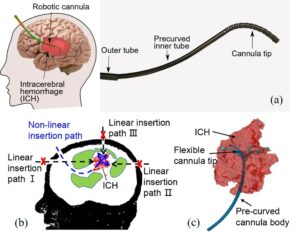CUHK
News Centre
CUHK wins four awards at the 13th Challenge Cup China College Students’ Entrepreneurship Competition
Students from The Chinese University of Hong Kong (CUHK) received four awards at the 13th Challenge Cup China College Students’ Entrepreneurship Competition (第十三屆「挑戰杯」中國大學生創業計劃競賽): a gold prize and a silver prize in the “science and technology innovation and future industry” category, a bronze prize in the “social governance and public service” category, and another bronze prize in the “eco-friendly and sustainable development” category.
The gold prize project: A Robotic Cannula for Minimally Invasive Intracerebral Hemorrhage Evacuation
Neurosurgery involves high-risk, highly complex operations that require great precision. Two PhD students at CUHK’s Department of Mechanical and Automation Engineering, Chen Jibiao and Yan Junyan, under the guidance of Professor Cheng Shing-shin, invented a new type of continuum robotic cannula for neurosurgery with a motion planning and navigation system. It consists of a straight or precurved rigid body and a flexible tip. The navigation system can reconstruct the brain map of the patient before operations, carry out preoperative and intraoperative motion planning and control, and customise the optimal cannula design based on the patient’s anatomy, enabling the cannula to be accurately positioned while minimising damage to normal brain tissue and improving the evacuation completeness of intracerebral hemorrhage. This new type of neurosurgical robotic cannula can be used not only for intracerebral hemorrhage evacuation but also for other neurosurgical and interventional procedures that require nonlinear trajectories. Please see the appendix for information about the other awards.
CUHK Pro-Vice-Chancellor Professor Sham Mai-har said, “CUHK is striving to create value and bring benefits to society. I would like to congratulate our students on receiving these prizes from the Hong Kong New Generation Cultural Association (HKNGCA), which recognises their efforts, creativity and potential in research, entrepreneurship and innovation. The University will continue to support and nurture students to be future leaders and work for the betterment of society.”
Director of CUHK’s Office of Research and Knowledge Transfer Services Professor Benny Zee added, “CUHK was rated by Reuters’ “Asia Pacific Region’s Most Innovative Universities” listing as the most innovative university in Hong Kong for a number of years. We strive to support students in their knowledge transfer journey by providing them with plentiful resources and professional advice. With a strong network across all kinds of businesses, we can help our students to find investment, advice and partners from industry. For the next step, we will help the awardees to gain more exposure by supporting them in developing strategies.”
The competition, organised by the HKNGCA, is the largest entrepreneurship platform for Chinese youth; the scale, number of entries and influence are second to none in the country. It aims to encourage students to explore technology, nurture complex, innovative talents, and promote the integration of enterprises, universities and scientific research institutes.

CUHK’s Department of Mechanical and Automation Engineering PhD students Yan Junyan (left) and Chen Jibiao.

a) Illustration of the proposed robotic cannula used for intracerebral hemorrhage evacuation.
b) Side view of the brain: When accessing a hematoma, a curved insertion trajectory allows avoidance of critical functional brain areas while keeping the cannula along the long axis of the hematoma.
c) The flexible tip provides dexterous local manipulation inside the hematoma.





